What stone sink is used for kitchen and bathroom?
Stone kitchen sinks and bathroom sinks are gradually gaining popularity among consumers. Usually they are based on 80% of porcelain stoneware, sinter or acrylic stone, 15% are polymeric binders that prevent the products from cracking, and 5% is a coloring pigment. Let us consider in more detail the configuration of stone sinks, try to choose the best sanitary ware on the market, and see how the sink in stone looks like for a kitchen and a bathroom.
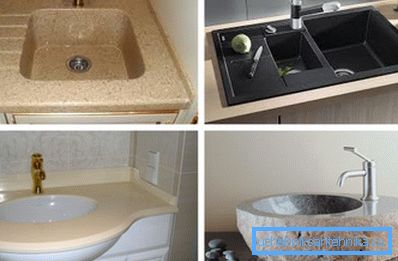
Stone kitchen sinks
In addition to high functionality, the products have an elegant and "expensive" appearance. Manufacturers offer a wide range of colors, so you can choose a model that fits well with the interior of the room.
You can also choose a mixer for the product that matches the granite in color and texture. The thickness of the sink is usually 8-14 mm, thus it is possible to extinguish the noise of falling water.
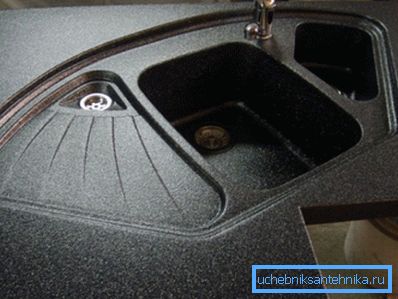
Selection
When choosing, consider the configuration of the product, which may be completely different.
The following are the most commonly used, although there are other options:
- oval;
- round,
- one and a half,
- with a wing;
- equipped with one or two bowls.
Products with 2 bowls are the most convenient to use in the kitchen. Due to the design, it is possible to do several things at once. The best combination with the model will be a mixer with a portable hose, and you can also use a tap with a pull-out spout.
To the surface of the sink of stone are attached as well as steel, requiring a tight fit.
Tip: when selecting the sanitary kitchen equipment, we recommend taking into account the required functionality, design and room size, as well as personal preferences.

What material is better for stone sink
We construct the paragraph as follows - we will tell about each separately, analyzing its positive and negative qualities, and then we will eventually try to come to some opinion.
Porcelain stoneware
- The composition of the material natural components, which acquire their properties under the action of high temperatures. After processing, it is resistant to wear and temperature changes, it becomes durable and reliable.
- In the production process, the raw material changes its crystal structure, obtaining the characteristics of a stone.
- Used for the manufacture of sinks, countertops, tiles and other materials for the interior.

Kitchen sink or bathroom sink can theoretically be made of marble or granite blocks, but its price will be incredibly high.
Characteristics of porcelain tile:
| Susceptibility | Natural material reacts to high humidity, elevated temperatures and mechanical stress. Thanks to the polymeric binder, these problems were reduced to a minimum. |
| Merits |
|
| Weak spots | Damage to the product can be a heavy load. The cleavage that appeared at the impact point must be restored as soon as possible. Although the products are quite expensive, but partly justifies their service life. |
Acrylic stone
The second name is artificial, its composition is as follows:
- mineral fillers;
- acrylic or polymeric resins;
- coloring pigments and hardeners.
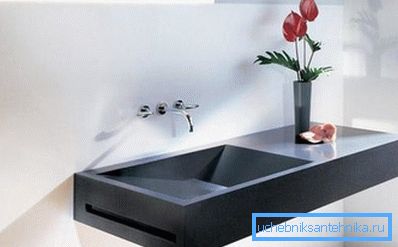
Features:
- They are made in the form of sheets, which are then joined with the help of glue into finished products.. Due to this, such a sink resembles a product, carved from a stone block.
- Due to the high content of artificial components, the material received plasticity, which makes it possible to bend the sink into the most intricate configurations.
Tip: if minor damage occurs during operation, shells can be quickly and easily repaired with your own hands.
- "Stone" does not absorb unpleasant odors, does not emit harmful substances, pleasant to the touch.
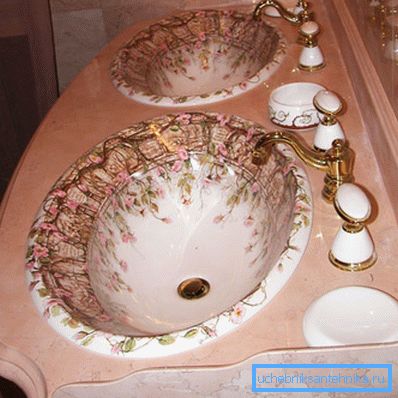
Material Disadvantages:
- Fears of heat, so boiling water should not be poured into such sinks.
- The instruction manual requires a special coating on the bowl, otherwise the sink may be stained by coffee, wine, fruit and berry juice.
- The cost of kitchen sinks is high, which is still unjustified.
Agglomerate
The composition of 80-95% consists of stone chips, the remaining percentage - polymer resin.
For the manufacture of sinks use the following agglomerates:
- granite;
- marble;
- quartz.
In appearance, agglomerate shells are difficult to distinguish from stone, even if you touch them, they will be just as smooth and cold. Therefore, this type of product is meant when discussing granite quartz or marble sinks.
The advantages of the material include:
- reliability;
- strength;
- high wear resistance;
- resistance to temperature extremes.
The structure of the agglomerate is low porous, which prevents water and odors from being absorbed, and also does not cause staining of the material. Sinks have a durable service life, are resistant to active chemicals, have a good appearance.
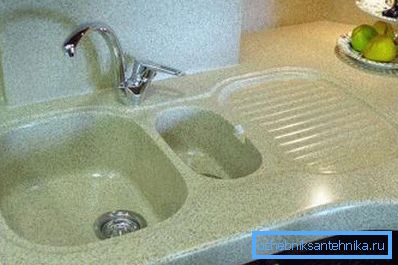
A weak spot is mechanical damage. At the same time, you can still get rid of scratches, but it will not be possible to restore the chips.
You also will not be able to meet the bizarre forms of agglomerate sinks, like acrylic counterparts, and the high cost of products is fully consistent with their performance.
Conclusion
Elite sanitary ware made of natural stone allows you to get a feeling of harmony and perfection in any setting. Today we have considered only some variants of materials, and there is also travertine, natural chalcedony and marble onyx with its rich structure.
A stone sink creates the effect of expensive and elegant simplicity in the kitchen or bathroom. The video in this article will provide an opportunity to find additional information on the above topic.